Reading Time: 9 minutes
A coir doormat lets guests know your house is sustainable from the first step, with the style and design that introduces people to your home. Cleaning it properly is essential to ensuring the mat’s longevity, effectiveness, and continued contribution to a more mindful, eco-friendly home.
You are watching: How to clean a coir doormat: The complete guide
What is coir?
Coconut coir is the fibrous outer layer of coconut husks, which end up as waste material during the industrial harvesting of coconuts, grown for the coconut flesh and water. Coconut husk comes in different grades and Coco Coir is now commonly used to produce organic, peat free compost, as an alternative to unsustainable Sphagnum peat-moss composts. You can learn more about coir compost and additionally our range of compressed coco peat blocks on our blog.
However, the longer course fibres from the husk are perfect for creating brushes, brooms and doormat bristles. They are hard wearing, anti-bacterial, natural and can be woven in different ways to provide different cleaning surface areas to suit all types of footfall and styles.
Benefits of coir doormats
Coir’s natural sustainability makes it a natural and eco-friendly alternative to synthetic fibre doormats. Synthetic, mostly polyester mats often contain harmful chemicals, shed microplastics and are highly polluting in the production process.
Coarse, hardwearing coir fibres easily remove dirt from the underside of shoes, literally acting as brushes on the bottom of your shoes. The fact that coir doormats have a higher profile than thin synthetic mats means they hold on to debris like stones, preventing it from being spread throughout your house or building. Synthetic mats on the other hand tend to solely absorb mud and water, but fail in keeping hold of the debris, which means they need cleaning more often.
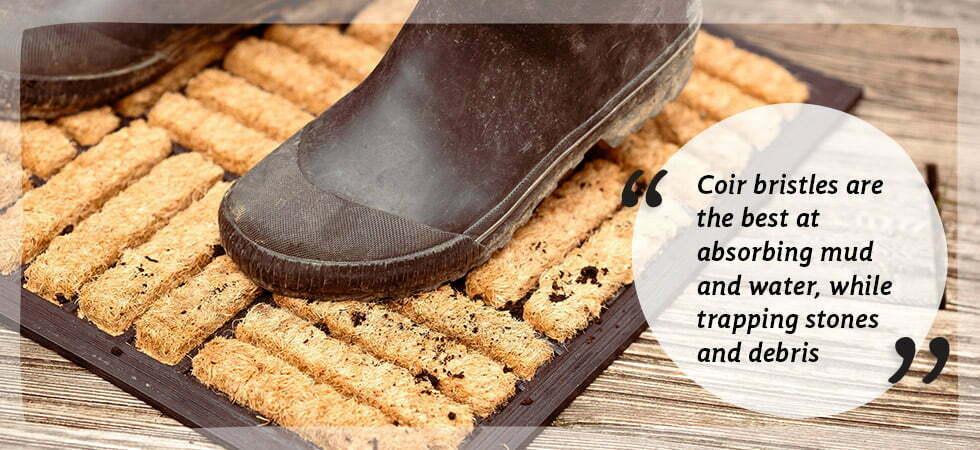
Naturally resistant to fungal and bacterial growth, thanks to the presence of lignin covering the coir fibres, our doormats are highly effective at keeping mould and mildew at bay. They also reduce bad smells which can start to develop over time through stagnating water. This means coir is an excellent material for both indoor and outdoor doormats exposed to dampness and the elements while being excellent for the environmentally conscious.
Cleaning a coir doormat
The best cleaning method will depend on whether the dirt within the mat is wet or dry, how long it has been there and the type of mat you have. Coco & Coir offer a number of different types of doormats. However, the main variations that require different attention are:
Outdoor doormats – Heavy duty, weather resistant outdoor mats often used as boot scrapers, which also let water drain away. un-printed.
Printed doormats – Stylish designs for indoor use and outdoor undercover. Need less vigorous cleaning to protect the printed design.
The good news is that coir doormats can be cleaned by a number of methods including vacuuming and hand washing. Despite what some manufacturers might try and claim – they cannot be machine washed! As they trap so much dirt though they only need occasional cleaning to be effectively maintained to continue to be effective at keeping mud and grime at the door. Yes, this means less cleaning!
How often they need cleaning though will obviously depend on the type of dirt coming into contact with the mat and the level of footfall. Dog walkers and hikers, or those who live or work on farms, will need to clean their mats more often and want to opt for an outdoor specific mat, which is best suited for removing mud off boots.
Dry cleaning a coir door mat
The dry clean method is often best for a quick clean to remove the dust, dried mud and small stones that become trapped within the bristles. It is less effective at removing baked on and very ingrained mud deep within the bristles, but is faster, simple and effective.
Take the opportunity to clean the area under and around the mat while it’s removed. The most effective way to clean your doormat without the hassle is by incorporating a quick doormat clean into your regular cleaning schedule. It’s amazing how many times people clean their house and not the door mat which protects it from getting dirty in the first place!
Brush off the top layer and loosen debris
With the easy to remove dried mud removed from the surface, it’s time to get a bit deeper. You can now see which areas on the surface have caught onto the tops of the bristles. Take a stiff brush and lightly flick the top of the mat to start removing the top layer of grime. With an outdoor doomat like the one below you can be more ruthless and get into the grooves and work the brusk into the mat to start loosening the trapped mud.
Read more : 4 Ways To Keep Cushions On Outdoor Furniture
With printed mats you need to be more careful to avoid scraping and brushing the design too hard and causing wear to the design. you might want to use a softer dustpan brush for your printed mats.
Gently beat dirt out of the fibres
Use a broom handle while hanging the mat or gently hit the doormat against an outside wall to release more stubborn dust and debris from deeper within the bristle fibres. Coir doormats may be tough, but try not to hit them too hard – you’ll want to avoid damaging the weave. A targeted approach to areas of caked on dirt is best!
Ideally you’d hang your mat to leave yourself with two hands to be able to hit particularly dirty areas and release ingrained mud. We do this with bulldog clips as washing line pegs are not strong enough, especially for the heavier outdoor mats. Resting the mat on its side works well though, but however you do this be careful not to overbend your mat, which can cause splitting if it is folded too far. This is why we recommend avoiding folding a mat over something like a hand rail.
These mats are sturdy enough to stand up on the side without folding and means you’re not putting pressure on the backing, even if it is durable. In particular if you leave your mats outside, all mat backing including rubber becomes weakened by being left in sub-zero temperature and then in the sun during summer.
The benefit of this method is by more but less impactful hitting you’ll work the small stones which are trapped by the bristles towards the surface. It is also better for printed doormats as you are not rubbing the surface of the mat.

Use a vacuum for a final, general clean
Once the loose dust and debris have been shaken off and beaten free, remove any remaining embedded loose dirt and stones with a vacuum cleaner. Use a lower setting and for printed mats and avoid using the brush or carpet setting, which can aggressively brush and wear the design.
Targeted spot cleaning of clumps of mud can be done by wiggling the bristles in a circle with the vacuum cleaner’s nozzle attachment to dislodge debris below the surface while pulling the mud up and out. As always it is not necessary to do any of this too hard so you avoid pulling too many coir fibres loose.
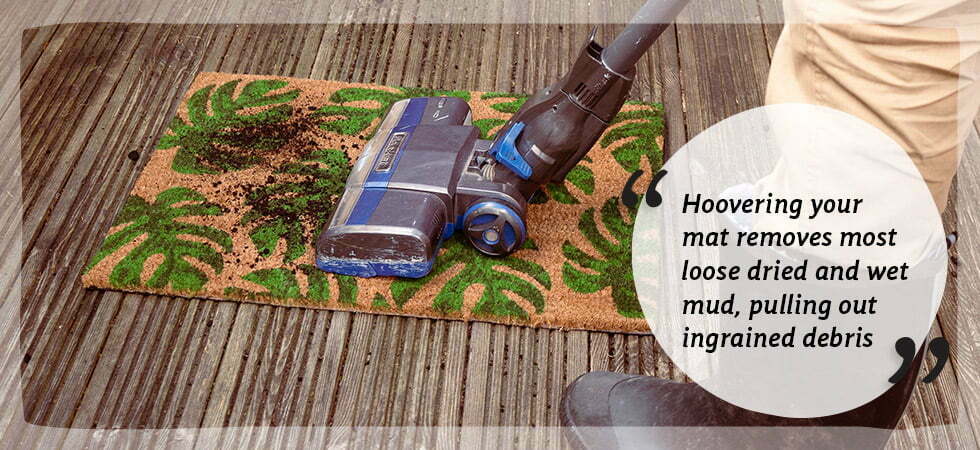
Outdoor mats are built with grooves and holes to allow water to drain away. These can of course get filled with mud and grime. This is where the trusty nozzle head of the vacuum comes in handy. You can easily run the nozzle down the lengths of the grooves to quickly clean these out.
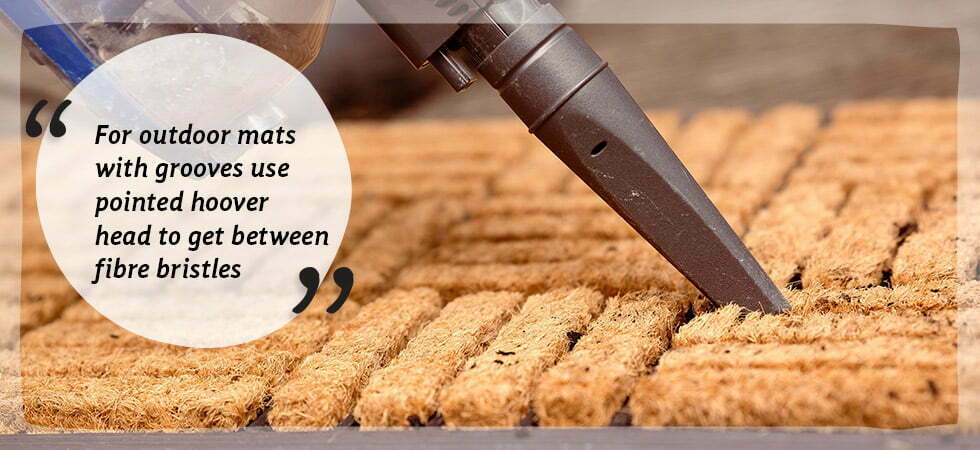
Need a bit more oomph to remove stubborn stains and soiling?
For heavy soiling and light staining lightly brush a natural powder cleaner such as bicarbonate of soda into the fibres. Work the powder in gently using a (yes we recommend a coir bristled hand brush) Leave for around 30 minutes or more, before vacuuming again to remove dislodged dirt and leftover powder.
We do not recommend using bleach as this removes the antibacterial lignin and it will change the colour of any design and the natural brown of the coir.
Cleaning a coir doormat with water
Giving your doormat a good hose down every few months or when the mat has become particularly dirty after a rainy, muddy autumn day. Ideally you’d not wash your mat when it is rainy of course, but if it is forecast to pour with rain why not leave your mat propped up on an angle and let the rain do the work!? Reducing water use is always a more eco-friendly option!
That said we have been known to use the shower in the bath, but the clean up operation to avoid mud and stones going down the plug isn’t often worth it!
You’d also ideally want to follow the previous dry cleaning steps first to avoid turning dry dirt on the mat into mud. Not removing the loose dirt makes it harder to remove as simply you need to wash more mud away. The great thing about coir bristles is their ability to hold mud and stones, whilst being so well draining. Avoid using a pressure washer or a flow that is too strong, but we use the “jet” setting on a standard adjustable hose head.
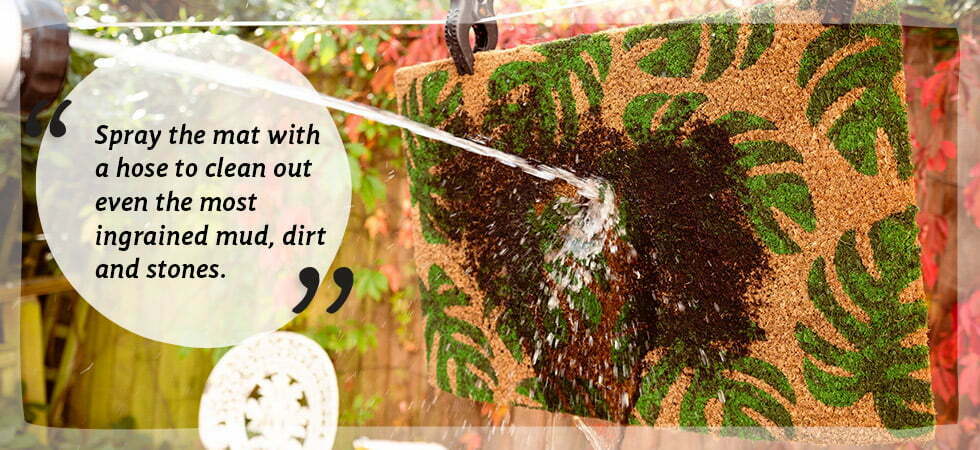
For an overall clean start at the top of the mat and work along horizontally across the mat before starting again from the same size a little further down. Working across and down the mat systematically means you can be sure you’ve covered the entire mat. This is important as the mud and grime will run down, so starting near the bottom or randomly means you are more likely to leave areas uncleaned.
To target a specific area of mud simply work from the top of the muddy area to the bottom.
Should the mat need more, or deeper cleaning, you can use warm water, a stiff-bristled brush, and a gentle natural cleaning agent. A biologically friendly soap like coconut soap is ideal. Using something like washing up liquid will work, but removes the natural oils which help protect your doormat’s bristles. Avoid harsh chemical detergents: coco coir is naturally sterile and antibacterial; there’s no need for pollutants. Chemicals can also be absorbed easily, which may cause discolouration or staining.
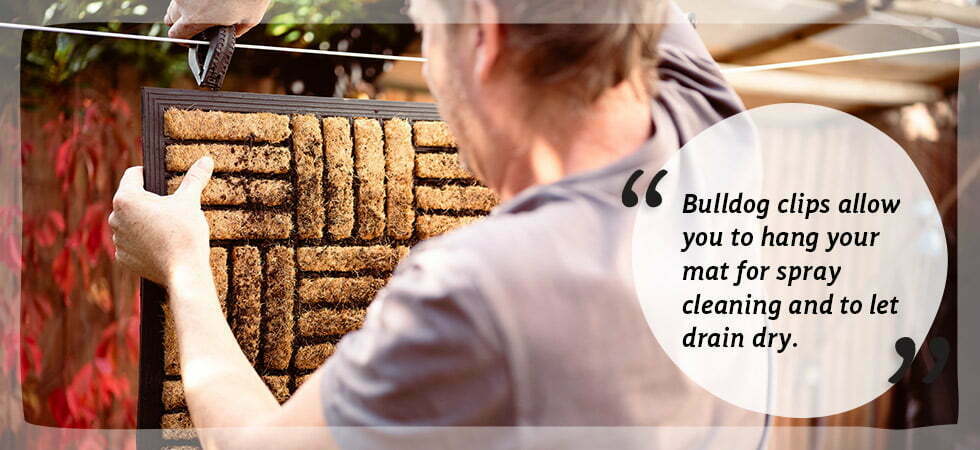
Use a brush and warm water to scrub the surface gently and reach the layers below. Rinse any cleaning residue from the mat and leave it to dry in a sunlit, airy place on its side to drain excess water and speed up the drying process.
Hang the mat or leave it to dry propped up so the water can drain freely down the mat, carrying with it the mud. As the bristles have a more open texture than synthetic It’s better to hang rubber-backed mats, as this helps avoid moisture collecting within.
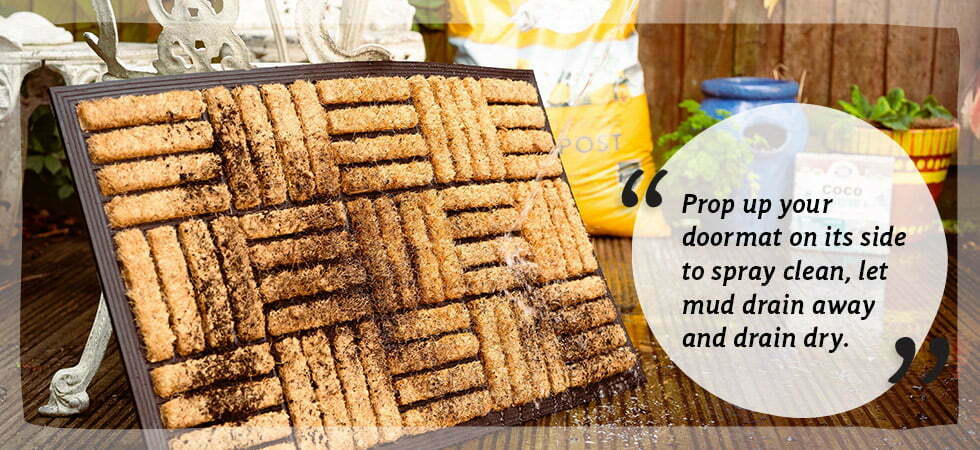
Make sure the doormat is completely dry before putting it back in place. You may want to check the back of the mat and rub down with a clean dry cloth to make sure the backing isn’t wet when you return it to an indoor doorway.
Removing deeper stains or spots from coir mats
More stubborn stains can be addressed with spot cleaning, using soap and water. Mess from pets or staining agents like should be covered with bicarbonate of soda to absorb as much liquid and odour as possible.
Leave the mat for as long as necessary, then knock the powder from the mat into a bin and assess which of the previous cleaning processes are still needed.
Oil stains can be loosened with a mixture of coconut oil, water, and white vinegar. If the bristles of the doormat are damaged, apply a light coating of coconut oil to help protect them.
Looking to bring the utility of a hard-wearing eco-friendly coir doormat to your home? Browse our range of beautiful, 60+ designs and styles to find a sustainable coir doormat that will complement your living space and interior design. Why not try:
Art Deco / Abstract mats
The Rainbow Doormat
Welcome Doormats
Christmas Doormats
Source: https://gardencourte.com
Categories: Outdoor

